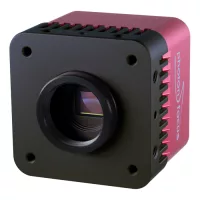Photonfocus MV0-D2048-C01-160-G2 Specifications
Ranked Nr. 163 of 126 2D Vision Systems

The camera series MV0-D2048(I)-C01-160-G2 is based on the CMOSIS CMV4000 V3 CMOS image sensor. The CMV4000 V3 CMOS image sensors are optimized for low light conditions and are available as standard monochrome and as NIR (I) version. The cameras have the GigE interface (GigEVision).
These cameras focus on demanding applications in industrial image processing. They are optimized for low light applications. Due to the global shutter, even high-speed applications with exposure times in the µs-area are possible.
FEATURES:
- Configurable region of interest (ROI)
- Up to 8 regions of interest (MROI)
- Decimation in y-direction
- 2 look-up tables (12-to-8Bit) on user-defined image region (Region-LUT)
- Constant frame rate independent of exposure time
- Crosshairs overlay on the image
- Temperature monitoring of camera
- Camera informations readable over SDK
- Ultra low trigger delay and low trigger jitter
- Extended trigger input and strobe output functionality
- Status line in picture
Choose your model:
DR0-D1920-S01-480-G2
Monochrome
MV0-D1280-O01-144-G2
Monochrome | Near-infrared
MV0-D2048-C01-160-G2
Monochrome | Near-infrared
MV0-D2592-O01-144-G2
Monochrome | Near-infrared
MV2-D2448-S01-G1
Monochrome
OEM0-D1984-O01-144-G2
Monochrome | Near-infrared
| Image Type |
|
| Resolution | 2048 |
| Dimensions |
MV0-D2048-C01-160-G2 Downloads
Photonfocus datasheet MV0 D2048 C01 160 G2
You need to
register
to download this file.












